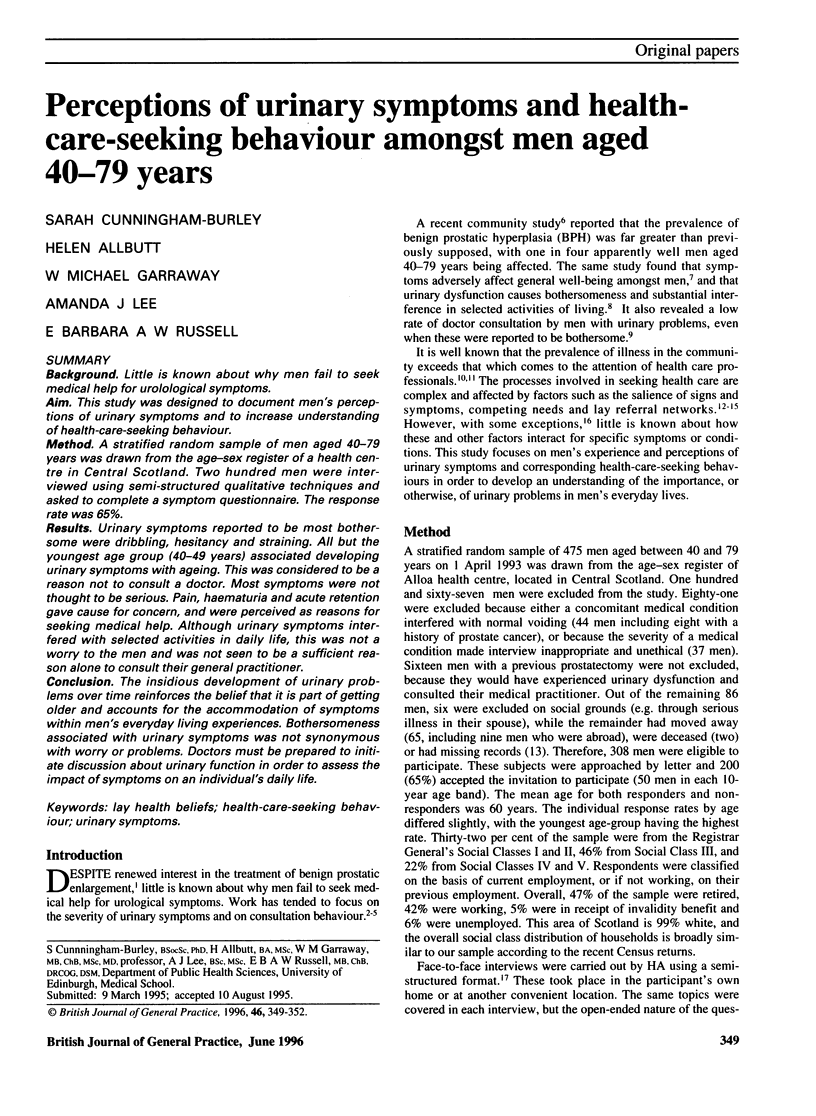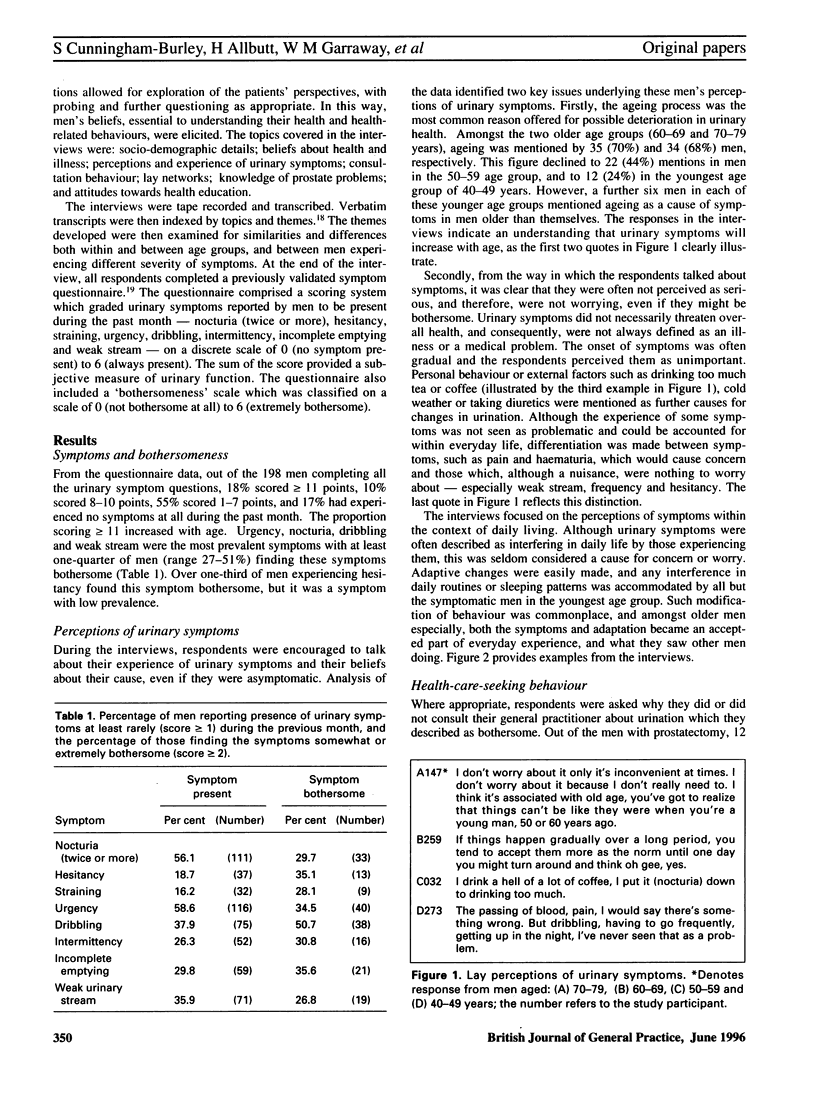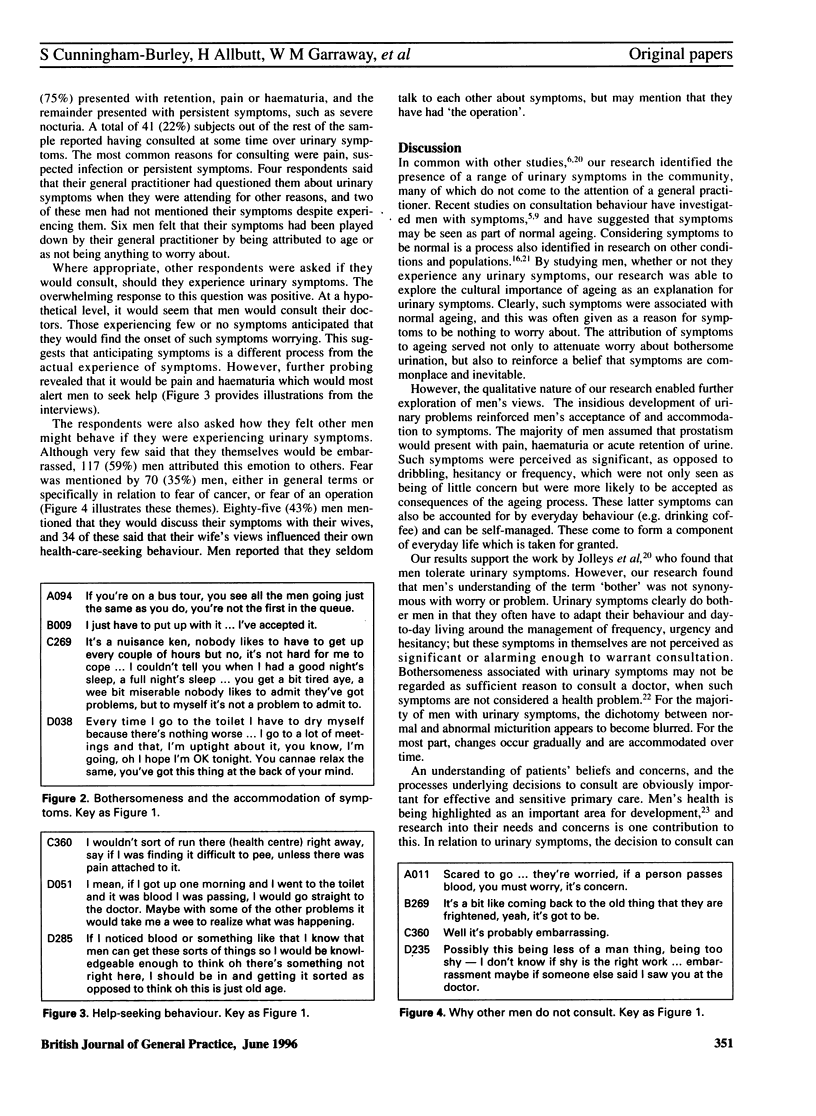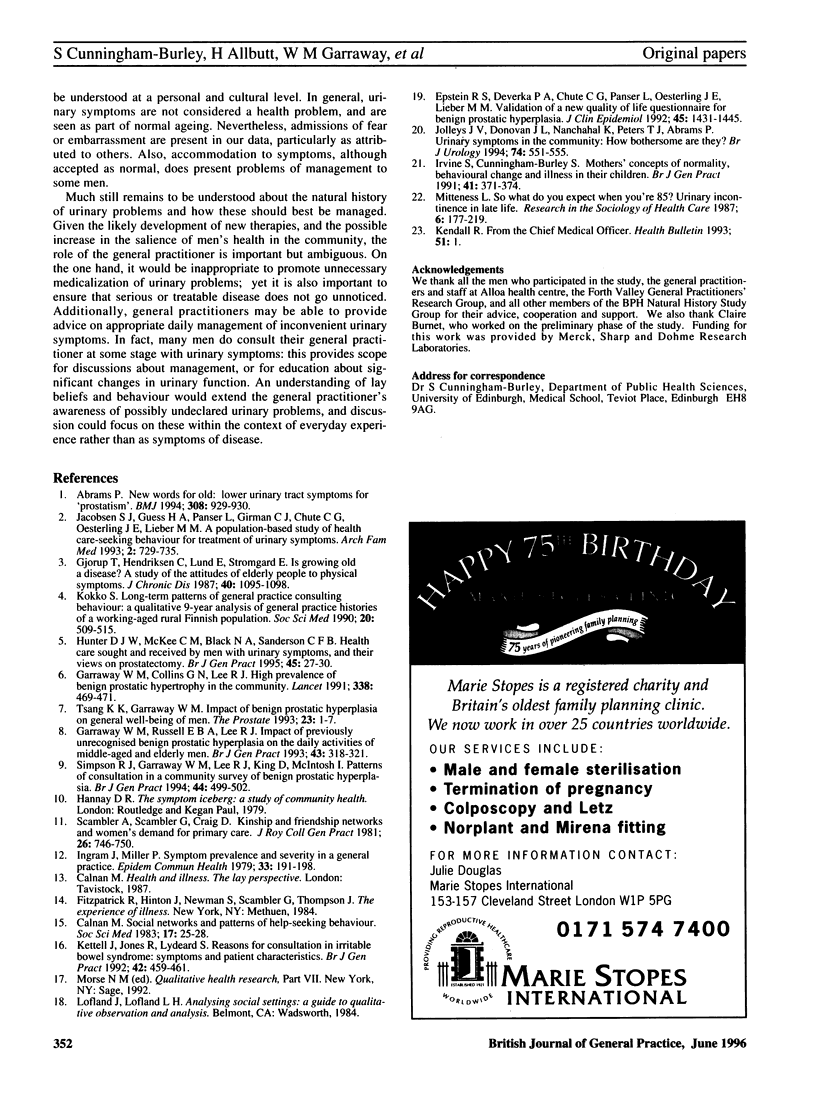Abstract
BACKGROUND: Little is known about why men fail to seek medical help for urological symptoms. AIM: This study was designed to document men's perceptions of urinary symptoms and to increase understanding of health-care-seeking behaviour. METHOD: A stratified random sample of men aged 40-79 years was drawn from the age-sex register of a health centre in Central Scotland. Two hundred men were interviewed using semi-structured qualitative techniques and asked to complete a symptom questionnaire. The response rate was 65%. RESULTS: Urinary symptoms reported to be most bothersome were dribbling, hesitancy and straining. All but the youngest age group (40-49 years) associated developing urinary symptoms with ageing. This was considered to be a reason not to consult a doctor. Most symptoms were not thought to be serious. Pain, haematuria and acute retention gave cause for concern, and were perceived as reasons for seeking medical help. Although urinary symptoms interfered with selected activities in daily life, this was not a worry to the men and was not seen to be a sufficient reason alone to consult their general practitioner. CONCLUSION: The insidious development of urinary problems over time reinforces the belief that it is part of getting older and accounts for the accommodation of symptoms within men's everyday living experiences. Bothersomeness associated with urinary symptoms was not synonymous with worry or problems. Doctors must be prepared to initiate discussion about urinary function in order to assess the impact of symptoms on an individual's daily life.
Full text
PDF



Selected References
These references are in PubMed. This may not be the complete list of references from this article.
- Abrams P. New words for old: lower urinary tract symptoms for "prostatism". BMJ. 1994 Apr 9;308(6934):929–930. doi: 10.1136/bmj.308.6934.929. [DOI] [PMC free article] [PubMed] [Google Scholar]
- Calnan M. Social networks and patterns of help-seeking behaviour. Soc Sci Med. 1983;17(1):25–28. doi: 10.1016/0277-9536(83)90075-8. [DOI] [PubMed] [Google Scholar]
- Epstein R. S., Deverka P. A., Chute C. G., Panser L., Oesterling J. E., Lieber M. M., Schwartz S., Patrick D. Validation of a new quality of life questionnaire for benign prostatic hyperplasia. J Clin Epidemiol. 1992 Dec;45(12):1431–1445. doi: 10.1016/0895-4356(92)90205-2. [DOI] [PubMed] [Google Scholar]
- Garraway W. M., Collins G. N., Lee R. J. High prevalence of benign prostatic hypertrophy in the community. Lancet. 1991 Aug 24;338(8765):469–471. doi: 10.1016/0140-6736(91)90543-x. [DOI] [PubMed] [Google Scholar]
- Garraway W. M., Russell E. B., Lee R. J., Collins G. N., McKelvie G. B., Hehir M., Rogers A. C., Simpson R. J. Impact of previously unrecognized benign prostatic hyperplasia on the daily activities of middle-aged and elderly men. Br J Gen Pract. 1993 Aug;43(373):318–321. [PMC free article] [PubMed] [Google Scholar]
- Gjørup T., Hendriksen C., Lund E., Strømgård E. Is growing old a disease? A study of the attitudes of elderly people to physical symptoms. J Chronic Dis. 1987;40(12):1095–1098. doi: 10.1016/0021-9681(87)90076-2. [DOI] [PubMed] [Google Scholar]
- Hunter D. J., McKee C. M., Black N. A., Sanderson C. F. Health care sought and received by men with urinary symptoms, and their views on prostatectomy. Br J Gen Pract. 1995 Jan;45(390):27–30. [PMC free article] [PubMed] [Google Scholar]
- Ingham J. G., Miller P. M. Symptom prevalence and severity in a general practice population. J Epidemiol Community Health. 1979 Sep;33(3):191–198. doi: 10.1136/jech.33.3.191. [DOI] [PMC free article] [PubMed] [Google Scholar]
- Irvine S., Cunningham-Burley S. Mothers' concepts of normality, behavioural change and illness in their children. Br J Gen Pract. 1991 Sep;41(350):371–374. [PMC free article] [PubMed] [Google Scholar]
- Jacobsen S. J., Guess H. A., Panser L., Girman C. J., Chute C. G., Oesterling J. E., Lieber M. M. A population-based study of health care-seeking behavior for treatment of urinary symptoms. The Olmsted County Study of Urinary Symptoms and Health Status Among Men. Arch Fam Med. 1993 Jul;2(7):729–735. doi: 10.1001/archfami.2.7.729. [DOI] [PubMed] [Google Scholar]
- Jolleys J. V., Donovan J. L., Nanchahal K., Peters T. J., Abrams P. Urinary symptoms in the community: how bothersome are they? Br J Urol. 1994 Nov;74(5):551–555. doi: 10.1111/j.1464-410x.1994.tb09182.x. [DOI] [PubMed] [Google Scholar]
- Kettell J., Jones R., Lydeard S. Reasons for consultation in irritable bowel syndrome: symptoms and patient characteristics. Br J Gen Pract. 1992 Nov;42(364):459–461. [PMC free article] [PubMed] [Google Scholar]
- Kokko S. J. Long-term patterns of general practice consulting behaviour: a qualitative 9-year analysis of general practice histories of a working-aged rural Finnish population. Soc Sci Med. 1990;30(4):509–515. doi: 10.1016/0277-9536(90)90354-u. [DOI] [PubMed] [Google Scholar]
- Scambler A., Scambler G., Craig D. Kinship and friendship networks and women's demand for primary care. J R Coll Gen Pract. 1981 Dec;31(233):746–750. [PMC free article] [PubMed] [Google Scholar]
- Simpson R. J., Lee R. J., Garraway W. M., King D., McIntosh I. Consultation patterns in a community survey of men with benign prostatic hyperplasia. Br J Gen Pract. 1994 Nov;44(388):499–502. [PMC free article] [PubMed] [Google Scholar]
- Tsang K. K., Garraway W. M. Impact of benign prostatic hyperplasia on general well-being of men. Prostate. 1993;23(1):1–7. doi: 10.1002/pros.2990230102. [DOI] [PubMed] [Google Scholar]


